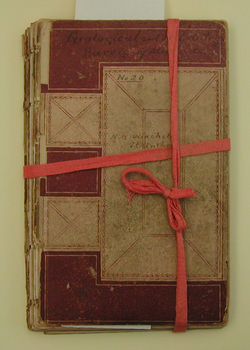The first dedicated study of the geology of Minnesota – and the discovery of the outstanding natural features of the state – is largely attributed to Newton Horace Winchell, the first director of the Minnesota Geological and Natural History Survey. Hired by the University of Minnesota in 1872 to oversee the state legislature’s mandate to the University’s Board of Regents to conduct an exhaustive survey of the state, Winchell began his field work in September of that year, performing a “general reconnaissance” of the parts of the state accessible by train. Railroad companies provided free passes to the State Geologist, who traveled throughout Minnesota (though only to parts then accessible by rail) and recorded evidence of Galena limestone, Niagara limestone, and noted that cretaceous clays and sandstones were present in the southern part of the state.
The University Archives preserves the Newton Horace Winchell papers, which contain Winchell’s field notebooks and the observations that he recorded while he performed his survey work. From a study of the potential use of mosses as a fuel source, to the commercial potential of the iron-rich region of the northwest portion of the state, Winchell’s accounts are the foundation of the scientific study of the natural resources of Minnesota.
 It is fitting then that the first complete collection to be scanned as part of the Exploring Minnesota’s Natural History project is the Newton Horace Winchell papers. The first notebook in the collection includes Winchell’s 1872 surveillance, as well as notes from research that he conducted at the Minnesota Historical Society regarding the earliest published accounts of Minnesota from missionaries and explorers (Fathers Hennepin and Marquette; LeSeuer, Carver, Schoolcraft). An overview of this historical research is included in the first official annual report of the survey, which he compiled. The annual reports of the first 24 years of the survey have already been digitized and are available on the University’s Digital Conservancy. The field notebooks, correspondence, and related papers used to compile these reports will soon be online, which will allow researchers to obtain even greater detail when conducting their own reconnaissance of Minnesota’s natural history.
It is fitting then that the first complete collection to be scanned as part of the Exploring Minnesota’s Natural History project is the Newton Horace Winchell papers. The first notebook in the collection includes Winchell’s 1872 surveillance, as well as notes from research that he conducted at the Minnesota Historical Society regarding the earliest published accounts of Minnesota from missionaries and explorers (Fathers Hennepin and Marquette; LeSeuer, Carver, Schoolcraft). An overview of this historical research is included in the first official annual report of the survey, which he compiled. The annual reports of the first 24 years of the survey have already been digitized and are available on the University’s Digital Conservancy. The field notebooks, correspondence, and related papers used to compile these reports will soon be online, which will allow researchers to obtain even greater detail when conducting their own reconnaissance of Minnesota’s natural history.
From Box 1, folder 1, notebook 1, an excerpt of Winchell’s observations of Stillwater, MN from 1872:
“At Stillwater a deep gorge tributary at least to the St. Croix, now filled with drift, seems westerly or northwesterly from the city. It is wide enough and deep enough to have accommodated the St. Croix R. yet I am rather disproved to regard it as only a preglacial valley tributary to the main valley. Such preglacial valleys are common along the Mississippi.”
Much more is to come on the Exploring blog about Winchell, but in the meantime, read Newton Horace Winchell: A Tribute from the Newton Horace Winchell School of Earth Sciences at the University of Minnesota.